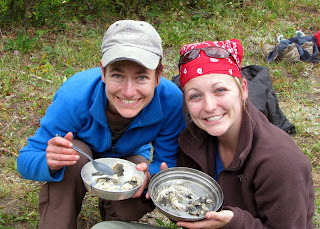1. Highly extraordinary or prodigious, exceptional.
2. Four days and 36 miles in the Wind River Range.
Seriously, wow. This was (one of) the best backpacking trips we've ever been on. Sheer granite peaks, strings of crystal clear lakes, and only three swats at mosquitoes. What more can you ask for in backpacking? Um, how about peaks over 13,000 feet? Yep, got em. Mystical mountains? Yes, Mordor is actually located here. Golden fish? Yes, in trout variety.
Here is the map of area we traversed, color coded by day. Because this blogging program is such a pain in the butt to work with photos, they are all (aside from the map) attached at the bottom, in semi-chronological order.

Day One: Feeling it Out, 8.7 miles
From Big Sandy Trailhead (9100') we had a late start on the trail at 3PM, but we easily covered our mileage up Freemont Trail, through Fish Creek Park, and past Dad's and Marm's Lakes (this didn't strike me as funny until I just listed them side by side and busted up). Our first camp was just below 10000' in a boulder field. Bill and I broke a cardinal backpacking rule by packing canned food, but this is our favorite meal in the wilderness and we didn't have time to dehydrate:
Day Two: Climbing Up, 8.2 miles
A chilly morning greeted us as we navigated our first pass, Washakie, at 11611', which was a rigorous climb up into what felt to be our grand entry into the Wind mountains. The wind whipped up and we dropped off the other side of the pass to rest by the lake below and snack on some gorp and salami, awestruck at the granite cliffs surrounding us.The rest of the day included a river crossing and a gradual ascent up to Valentine Lake, 10400'. We found some tiny but tasty huckleberries along the way.
Hanging the bear bag proved to be challenging that night, and Leighton suffered a minor mishap when our supporting branch broke off as we tried to hoist the heavy bag up (via pulling the rope and pushing up on the bag from underneath it). The branch snapped, and L got a good sideswipe to the face from the heavy, falling bag. Luckily, no serious harm done.
Day Three: Striding it Out, 11.2 miles and 2 passes
After due consideration we decided we'd rise early enough to let the moonlight guide some of our hike. Up at 4 AM, no one complained much as we rubbed the sleep out of our eyes, swung our packs on, and headed up the second pass, onto Lizard Head Trail. The climb was more gradual than anticipated, and probably less intimidating in the gray dawn hours. As we crested the top, approaching but not quite reaching 12000', we were greeted with a golden sunrise. The ridge hike along the Lizard Head was a bit hilly, with jaw-dropping views of the Continental Divide to the west. The well-delineated trail ultimately dissipated and we resorted to following rock cairns for a few miles. Coming off Lizard Head we spotted our one and only black bear who dashed off several hundred feet below us. It was a fast and steep decent from the ridge into Lizard Head Meadows, back to 10000', where we hunkered down for an afternoon nap.The Lizard Head Meadows are a gorgeous, lush setting with the meandering Popo River and the Cirque of the Towers beckoning in the background. There was plenty of good fishing to be had, and I added a few trout to our lunch. (Our Grandpa Jack still talks about flying over the Winds in his Cesnna prop plane and looking down to see the lakes a golden hue due to the abundance of golden trout living there.) Once our bellies had been filled and our feet had rested up, we loaded up again, and headed toward the towers.
The Cirque has reportedly drawn trad climbers since the 1940s and has been described as an "alpine climber's Disneyland"...interpret at will. I, for one, was happy to be on the ground gazing up. I was also happy not to be carrying 50 extra pounds of rope and cams. But we passed plenty of people on the trail who were eagerly racing to the base of the peaks to start the ascent up them.
When we reached Lonely Lake, nestled just beneath the Towers, we decided to waylay making camp and head up Jackass Pass before we called it a day. It's a short, steep climb, but at the summit, we were smacked in the face with cold winds and horizontal rain, so we hunkered beneath a conveniently sloped boulder a little higher on the mountain. We waited out the rain for an hour or so, then plunged off the other side of Jackass and onto our next challenge: the boulder garden.
At the base of Jackass Pass sits Arrowhead Lake. This is basically a booby trap for those brave enough to try and reach the Cirque. To navigate the lake requires a scramble over the massive boulder field bordering the western edge of the water. Giant boulders, with no real clear-cut method of passage, make for an adrenaline-spiked scramble, which--for us-- included hoisting the dog up and over several spots. The rain had slicked the surface of the boulders, so that spiced up our passage as well. (Unbeknownst to us until much later, there is a hiker's trail to the east of the lake which is much less technical, and probably way less fun. The path we took is known as the climber's trail.)
Once safely beyond the boulder field, the rain and scrambling had slowed us up and dusk was setting in. We set up camp at the next flat spot and settled into a rousing game of Mormon Bridge, a card game which probably doesn't exist outside of Idaho and Utah, but which should, because it's obviously very fun. (I actually just googled this, and it's also known as "Oh Hell", "Screw Your Neighbor", and "Oh Jerusalem". There you go.)
Day Four: Parting is Such Sweet Sorrow, 7.3 miles
More gorgeous lakes and peaks along the gradual decent from Big Sandy Lake to the parking lot. Blistered and bone-tired, we took the packs off and loaded up into the truck for the long, reminiscent drive home.


 |
| Cass, Josh, Leighton, Taniesha,Bill, and Stew-dog |
 |
| At the top of Washakie Pass. |
 |
| Payson Peak. |
 |
| Approach to Lizard Head Trail. |
 |
| The last part of the ridge, Lizard Head Trail. |
 |
| Lizard Head Peak, with the Cirque of the Towers in the background. |
 |
| Fish for lunch. |
 |
| The Cirque, with Pingora Peak on the right. |
 |
| The Boulder Problem at Arrowhead Lake. |
 |
| Last glimpses of Big Sandy Trail. |
 |
| Stewie, get in the back of the truck. |





















